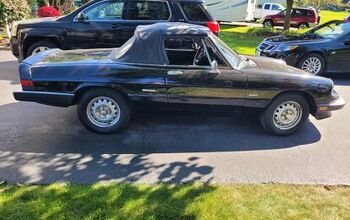Once Again, Canada Gets a Mercedes-Benz the Americans Can't Have

There’s more to living in Canada than just higher taxes, polar bear incursions, and brutally cold weather. For some reason, denizens of the Great White North are allowed to enjoy more choice at the bottom of the Mercedes-Benz model range.
For example, Americans can be forgiven if they weren’t aware of the B-Class Electric Drive, a low-volume EV hatchback that bit the dust late last year. MB sold just 744 of them in the U.S. in 2017. Meanwhile, Canadians can still walk into their local dealer and sign on for a 2018 B250, the conventional variant powered by the CLA-Class’ turbocharged 2.0-liter four-cylinder.
The EV model never made its way north of the border, while the conventional model never made its way south of the 49th Parallel.
On Friday, the automaker pulled the wraps almost all of the way off its new A-Class — a more refined front-drive entry-level model making its first foray into the North American market. Designed to lure buyers who wouldn’t otherwise have considered the brand, the A-Class will spawn a five-door and sedan variant in Europe, while American buyers can expect only the four-door. And Canada? Well, the country that really hates choice in wireless carriers and dairy products somehow gets the five-door, too.
“Our U.S. colleagues have already confirmed that they will only sell the sedan version of the A-Class,” said Brian D. Fulton, President and CEO of Mercedes-Benz Canada, on Friday. “Both hatchback and sedan versions will be available in Canada; we will share more information about the sedan later this year.”
Despite the public’s increasing love for trucks and SUVs, a trend that’s just as strong north of the border as south, Canadian car buyers still retain a desire for small, entry-level hatchbacks. Why else would Nissan frustrate TTAC’s Chris Tonn by offering the Micra in that market, but not the U.S.?
With the shark-nosed A-Class, the brand hopes it can attract buyers with a tony badge and an interior Daimler AG chief design officer Gorden Wagener calls “modern luxury at a level previously unattained in this class.”
So far, the sedan variant remains under wraps, but the five-door’s appearance is locked into place. In the Canadian market, the A-Class Hatchback holds 13.1 cubic feet of cargo behind the rear seats. Up front, the A250 (apparently, in both bodystyles) carries a turbocharged 2.0-liter four-cylinder good for 221 horsepower and 258 lb-ft of torque, mated to a seven-speed dual-clutch automatic. Available 4Matic all-wheel drive can be had for extra greenbacks (or loonies).
17-inch wheels come standard on the A-Class, with 18-inchers optional. The car’s rear axle is mounted on a subframe that further isolates the body from road vibrations via rubber bushings. Inside, the model’s claim to fame is a dual-screen system that dominates the dash. These screens, offered in 7.0 or 10.25-inch versions, offer users access to the automaker’s new MBUX (Mercedes-Benz User Experience) multimedia system. There’s too many connectivity features to list; suffice it to say Mercedes-Benz is making a serious play for the plugged-in Millennial market.
The 2019 A-Class arrives in both the United States and Canada late this year. Pricing hasn’t been announced, but it’s expected the model’s MSRP will undercut that of the CLA (and in Canada, the B-Class).
[Images: Daimler AG]

More by Steph Willems
Latest Car Reviews
Read moreLatest Product Reviews
Read moreRecent Comments
- Flashindapan Beautiful color combinations. I assumed they stop selling the TT here at least five or six years ago.
- Carson D Just don't be the whistleblower who reports on the falsification of safety data. That's a deadly profession.
- Carson D I'd have responded sooner, but my computer locked up and I had to reboot it.
- Todd In Canada Mazda has a 3 year bumper to bumper & 5 year unlimited mileage drivetrain warranty. Mazdas are a DIY dream of high school auto mechanics 101 easy to work on reliable simplicity. IMO the Mazda is way better looking.
- Tane94 Blue Mini, love Minis because it's total custom ordering and the S has the BMW turbo engine.



































Comments
Join the conversation
I get the impression a lot of you guys are younger and live in urban areas. Not a bad thing, mind you, but the lens you're looking through may not accurately reflect the overall market. The little urban commuter is a niche market. A luxury urban commuter is a niche within a niche.
Can it be true, a Mercedes Benz that doesn't make me want to unload my guts all over the pavement? I'm surprised. The other day I saw the first BMW in about a decade that looked pretty neat. Maybe styling trends are shifting for the big Germans.